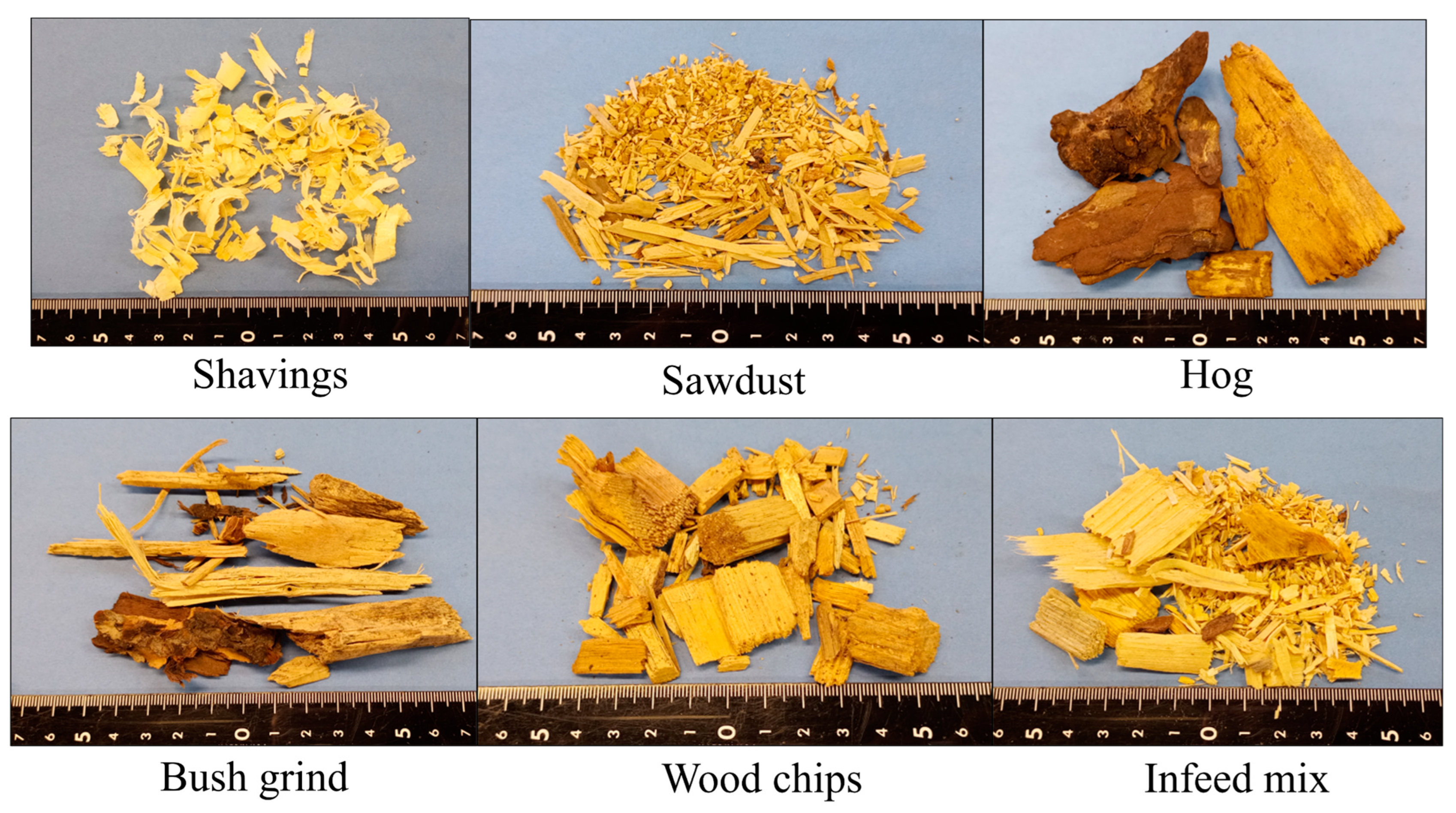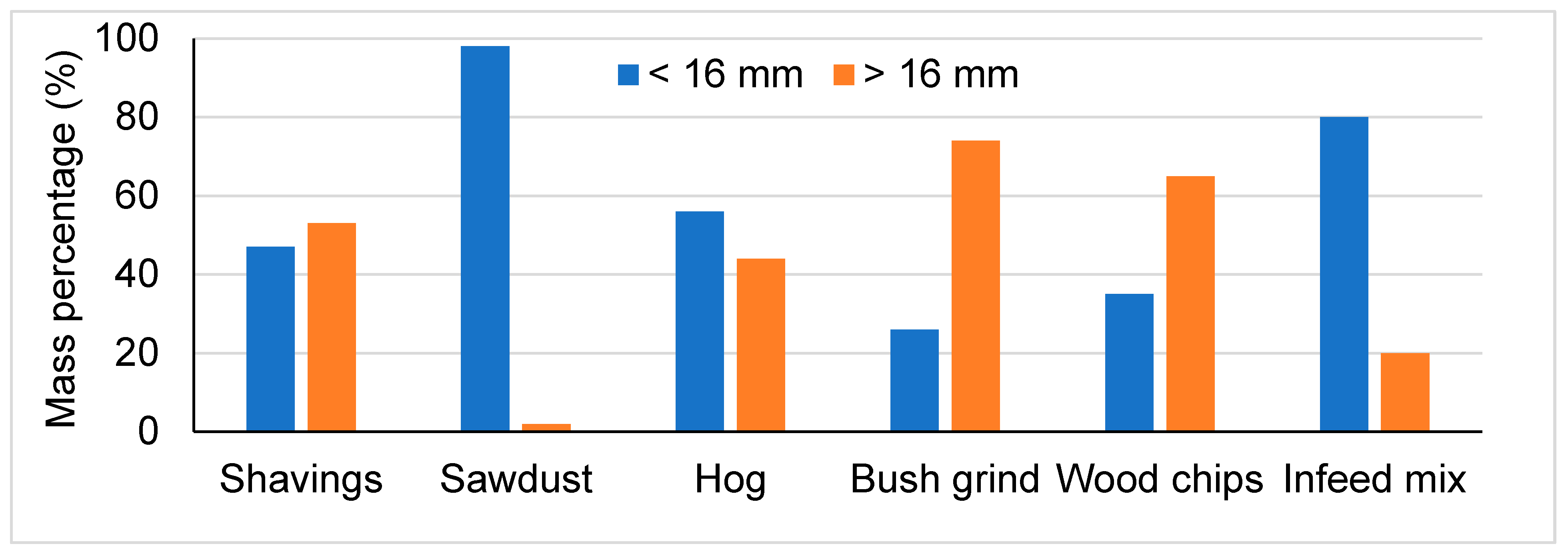Variability in Physical Properties of Logging and Sawmill Residues for Making Wood Pellets
Abstract
:1. Introduction
Objective
2. Materials
3. Methods
Statistical Analysis
4. Results
4.1. Particle Size before and after Hammer Milling
4.2. Impurities and Bark in Feedstock
5. Discussion
6. Conclusions
- Almost half of the feedstock types were non-sawdust, such as hog, chipped wood, and bush grind. The highly variable biomass arriving at the gate of the pant needed to be sorted out.
- The presence of small sand and stone particles was associated with bark content. The hog fraction had the highest ash content because of its high bark and extraneous material content.
- The application of ISO Standard 19743 to estimate the extraneous material (material other than biomass) content failed to account for small sand particles that may remain in the bark. Modification of this standard may be required.
- The current fractionation of feedstock is based on size and density detected using mechanical devices. To the knowledge of the authors, advanced instrumental techniques such as spectral analysis and automated vision are not employed and therefore should be developed.
Author Contributions
Funding
Data Availability Statement
Acknowledgments
Conflicts of Interest
References
- Ibrahim, H.; Farag, M.; Megahed, H.; Mehanny, S. Characteristics of Starch-Based Biodegradable Composites Reinforced with Date Palm and Flax Fibers. Carbohydr. Polym. 2014, 101, 11–19. [Google Scholar] [CrossRef] [PubMed]
- Strauss, W. Wood Pellet Markets Outlook: A Look at the Pellet Export Markets in 2022 and Beyond. Canadian Biomass Magazine, 2022. [Google Scholar]
- ISO 17225-2; Solid Biofuels—Fuel Specifications and Classes Part 2: Graded Wood Pellets. International Organization for Standardization: Geneva, Switzerland, 2021.
- ST 1001:2022; Wood Pellets—Requirements for Companies, 1st ed.; Bioenergy Europe/DEPI ENplus®. Bioenergy Europe: Brussels, Belgium, 2022.
- Watters, A.; Hayes, P. Wood Pellets for Heat and Power; United States Department of Agriculture: Ottawa, ON, Canada, 2021; pp. 1–7.
- Spelter, H.; Toth, D. North America’s Wood Pellet Sector; U. S. Department of Agriculture, Forest Service, Forest Products Laboratory: Madison, WI, USA, 2009; pp. 1–21.
- Visser, L.; Hoefnagels, R.; Junginger, M. Wood Pellet Supply Chain Costs—A Review and Cost Optimization Analysis. Renew. Sustain. Energy Rev. 2020, 118, 109506. [Google Scholar] [CrossRef]
- Bull, G.; Bennett, B.; Thrower, J.; Williams, J. Wood Pellets in BC—Wood Biomass Used in the Industry. 2022. Available online: https://pellet.org/resources/wpac-fibre-study-british-columbia-pellets-are-responsibly-sourced/ (accessed on 22 December 2023).
- Naimi, L.; Oveisi, E.; Sokhansanj, S.; Sowlati, T.; Lau, A.; Bi, X.; Jim Lim, C.; Melin1, S.; Igathinathane, C.; Skea, D.; et al. The Performance (Quality) of Size Reduction of Woody Biomass; ASABE: St. Joseph, MI, USA, 2009. [Google Scholar]
- Adam, R.; Pollex, A.; Zeng, T.; Kirsten, C.; Röver, L.; Berger, F.; Lenz, V.; Werner, H. Systematic Homogenization of Heterogenous Biomass Batches—Industrial-Scale Production of Solid Biofuels in Two Case Studies. Biomass Bioenergy 2023, 173, 106808. [Google Scholar] [CrossRef]
- Badger, P.C. Processing Cost Analysis for Biomass Feedstocks ORNL/TM-2002/199; Oak Ridge National Laboratory: Oak Ridge, TN, USA, 2002; pp. 1–52.
- Tchobanoglous, G.; Kreith, F. (Eds.) Handbook of Solid Waste Management, 2nd ed.; McGraw-Hill Education: New York, NY, USA, 2002; ISBN 978-0-07-135623-7. [Google Scholar]
- Wood Pellet Association Canada. Safer Operation of Direct Heated Belt Dryers; Final Report; Wood Pellet Association Canada: New York, NY, USA, 2022. [Google Scholar]
- Lee, J.S.; Rezaei, H.; Gholami Banadkoki, O.; Yazdan Panah, F.; Sokansanj, S. Quality Infeed: Characterization and Pre-Treatment of Residues for Making Wood Pellets. Canadian Biomass Magazine, 2023. [Google Scholar]
- ISO 18122; Solid Biofuels—Determination of Ash Content. International Organization for Standardization: Geneva, Switzerland, 2012.
- ISO 18125; Solid Biofuels—Determination of Calorific Value. International Organization for Standardization: Geneva, Switzerland, 2017.
- ISO FDIS 19743; Solid Biofuels—Determination of Content of Heavy Extraneous Materials Larger than 3.15 Mm. International Standards Organization: Geneva, Switzerland, 2016.
- Rezaei, H.; Lim, J.; Sokhansanj, S. Comparison of Drying Rates of Ground Western Red Cedar with Hemlock, Birch, Aspen, and Spruce/Pine/Douglas Fir. Appl. Eng. Agric. 2020, 36, 159–165. [Google Scholar] [CrossRef]
- Nosek, R.; Holubcik, M.; Jandacka, J. The Impact of Bark Content of Wood Biomass on Biofuel Properties. BioResources 2016, 11, 44–53. [Google Scholar] [CrossRef]
- Dhiman, J.; Shrestha, A.; Fasina, O.; Adhikari, S.; Via, B.; Gallagher, T. Physical, Ignition, and Volatilization Properties of Biomass Feedstock Dusts. Trans. ASABE 2015, 58, 1425–1437. [Google Scholar] [CrossRef]
- Alamia, A.; Ström, H.; Thunman, H. Design of an Integrated Dryer and Conveyor Belt for Woody Biofuels. Biomass Bioenergy 2015, 77, 92–109. [Google Scholar] [CrossRef]
- Peng, Y.; Lau, A.K. Improving the Quality of Crop Residues by the Reduction of Ash Content and Inorganic Constituents. J. Biobased Mater. Bioenergy 2020, 14, 209–219. [Google Scholar] [CrossRef]
- Werkelin, J.; Skrifvars, B.-J.; Hupa, M. Ash-Forming Elements in Four Scandinavian Wood Species. Part 1: Summer Harvest. Biomass Bioenergy 2005, 29, 451–466. [Google Scholar] [CrossRef]
- Lindström, E.; Öhman, M.; Backman, R.; Boström, D. Influence of Sand Contamination on Slag Formation during Combustion of Wood Derived Fuels. Energy Fuels 2008, 22, 2216–2220. [Google Scholar] [CrossRef]
- Moya, R.; Rodríguez-Zúñiga, A.; Tenorio, C.; Valdez, J.; Valaert, J. Pellets Evaluation Made from Tropical-Climate Agricultural and Forestry Crops of Costa Rica with a Domestic Stove. Waste Biomass Valorization 2015, 6, 1037–1046. [Google Scholar] [CrossRef]






| Property | Unit | I1 | I2 | I3 |
|---|---|---|---|---|
| Diameter, D | mm | 6 ± 1 | 6 ± 1 | 6 ± 1 |
| Length, L | mm | 3.15 < L ≤ 40 | 3.15 < L ≤ 40 | 3.15 < L ≤ 40 |
| Moisture, M | % wb | M ≤ 10 | M ≤ 10 | M ≤ 10 |
| Ash, A | % db | A ≤ 1.0 | A ≤ 1.5 | A ≤ 3.0 |
| Mechanical durability, DU | % | 97.5 ≤ DU ≤ 99.0 | 97.0 ≤ DU ≤ 99.0 | 96.5 ≤ DU ≤ 99.0 |
| Fines, F | % | F ≤ 4.0 | F ≤ 5.0 | F ≤ 6.0 |
| Gross calorific value, Q | MJ/kg | Q ≥ 18 | Q ≥ 18 | Q ≥ 18 |
| Bulk density, BD | kg/m3 | BD ≥ 600 | BD ≥ 600 | BD ≥ 600 |
| Type | Plant 1 | Plant 2 | Plant 3 | Plant 4 |
|---|---|---|---|---|
| Shavings | 30 | 23 | 35 | 5 |
| Sawdust | 46 | 19 | 20 | 7 |
| Hog | 3 | 0 | 9 | 58 |
| Bush grind | 11 | 2 | 34 | 0 |
| Wood chips | 0 | 37 | 0 | 0 |
| Unknown blend | 10 | 20 | 2 | 30 |
| Type | m.c. (% wb) 1 | Ash (% db) 2 | Bulk Density (kg/m3) | Particle Density (kg/m3) | Gross Calorific Value MJ/kg (Dry) | Smoking Temperature (°C) 3 |
|---|---|---|---|---|---|---|
| n = 30 | n = 30 | n = 30 | n = 10 | n = 30 | n = 20 | |
| Sawdust | 44 a (6) | 1.0 a (0.7) | 232 a (53) | 513 a (24) | 20.2 a (0.8) | 164 a (9) |
| Shavings | 11 b (3) | 0.4 ab (0.2) | 73 b (29) | 489 b (21) | 20.0 a (0.5) | 162 a (6) |
| Chips | 27 c (14) | 0.4 b (0.1) | 279 c (74) | 453 c (84) | 20.1 a (0.5) | 162 ab (7) |
| Hog | 50 a (9) | 2.8 c (1.4) | 270 c (76) | 445 c (91) | 20.6 b (1.0) | 158 b (6) |
| Bush grind | 32 c (11) | 1.7 a (1.0) | 209 a (62) | 471 c (53) | 20.3 a (0.3) | 172 ab (6) |
| Infeed mix | 39 c (14) | 1.2 a (0.7) | 231 c (70) | 359 d (66) | 20.2 a (0.5) | 167 ab (4) |
| Infeed Type | %EM (db) | Bark Content (% wt) |
|---|---|---|
| Sawdust | 0.04–1.12 | 5–15 |
| Hog | 0.03–8.24 | 25–55 |
| Bush grind | 0.10–0.93 | 20–30 |
| Infeed mix | 0.05–0.63 | 15–20 |
| Parameters | Plant 1 (n = 5) | Plant 2 (n = 5) | Plant 4 (n = 5) | Averages (n = 15) |
|---|---|---|---|---|
| Hog content (% wt.) | 3 | 9 | 58 | |
| m.c. (% wb) | 5.0 | 3.6 | 6.4 | 5.0 |
| Ash (% db) | 0.3 | 0.9 | 1.9 | 1.0 |
| Bulk density (kg/m3) | 633 | 645 | 655 | 644 |
| Gross calorific value (MJ/kg dry) | 19.9 | 20.0 | 20.1 | 20.0 |
| Smoking temperature (°C) | 167 | 165 | 162 | 165 |
Disclaimer/Publisher’s Note: The statements, opinions and data contained in all publications are solely those of the individual author(s) and contributor(s) and not of MDPI and/or the editor(s). MDPI and/or the editor(s) disclaim responsibility for any injury to people or property resulting from any ideas, methods, instructions or products referred to in the content. |
© 2024 by the authors. Licensee MDPI, Basel, Switzerland. This article is an open access article distributed under the terms and conditions of the Creative Commons Attribution (CC BY) license (https://creativecommons.org/licenses/by/4.0/).
Share and Cite
Lee, J.S.; Rezaei, H.; Gholami Banadkoki, O.; Yazdan Panah, F.; Sokhansanj, S. Variability in Physical Properties of Logging and Sawmill Residues for Making Wood Pellets. Processes 2024, 12, 181. https://doi.org/10.3390/pr12010181
Lee JS, Rezaei H, Gholami Banadkoki O, Yazdan Panah F, Sokhansanj S. Variability in Physical Properties of Logging and Sawmill Residues for Making Wood Pellets. Processes. 2024; 12(1):181. https://doi.org/10.3390/pr12010181
Chicago/Turabian StyleLee, Jun Sian, Hamid Rezaei, Omid Gholami Banadkoki, Fahimeh Yazdan Panah, and Shahab Sokhansanj. 2024. "Variability in Physical Properties of Logging and Sawmill Residues for Making Wood Pellets" Processes 12, no. 1: 181. https://doi.org/10.3390/pr12010181






